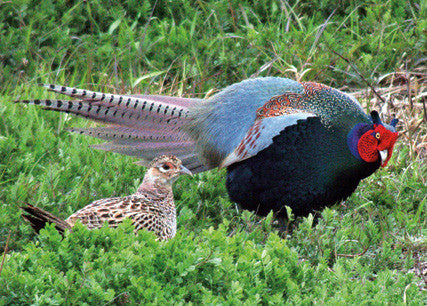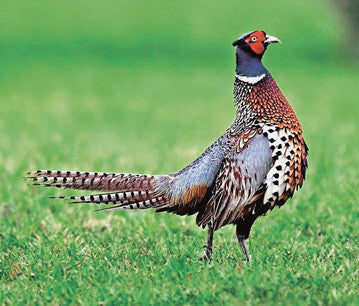










True Pheasants: a noble quarry
Details
By: Pfarr, James
ISBN-13: 978-0-88839-702-7
Binding: Trade Cloth
Size: 8.5" X 11"
Pages: 248
Photos: 266
Illustrations: 50
Publication Date: 2012
Description
PR Highlights: A tribute to the spectacular true pheasants.
PHOTO Highlights: Color images throughout, museum photos
Table of Contents
Description: The family Phasianidae includes some of nature's most striking avian gems. Not only are they among the grandest, most sought after in aviculture, they are as diverse and breathtaking as the landscapes they inhabit. The genus Phasianus or 'true pheasants' has the most expansive range of all. This work introduces the entire genus.
For the first time this group has been documented by the largest compilation of skins to date, providing a tangible and accurate guide for aviculture as well as bringing awareness to these magnificent and grossly overlooked game birds. Considered by many to be jewels of nature, Phasianus faces elimination in its Asian range, and hybridization in captivity. Wishing to preserve for posterity the true phenotypes, the author presents an in-depth study of this genre, which includes actual museum specimens, detailed anatomical plates, helpful identification methods and distribution information.
Author Biography
Author Biography:
James Pfarr is a lifelong hobbyist and propagator of pheasants and other galliformes, pursuing their preservation in aviary and the field. He has been involved with numerous aviculture organizations spanning twenty-five years. As an avid outdoorsman, he has a deep appreciation for conservation. A structural engineer by trade, he resides in Washington State where he continues to rear pheasants and take pleasure in the gifts of the outdoors.
Book Reviews
Book Review by Willy Newlands for Cage and Aviary Birds, August 2012
The true pheasant, the bird many people would know as 'the ringneck' and which is labelled by science as Phasianus colchicus, is not only one of the most valuable birds in the world but also one of the least understood. On one hand, millions of pounds are spent on pheasant hunting all around the world. And millions of pheasants are reared for sport. On the other hand, very little is known about the bird itself - where the 33 sub-species actually live, how they are doing in the wild, whether the native pheasants found scattered all across Asia, from Turkey to Japan, are being polluted by the gamebird industry's introduced mongrels. And could you tell, by looking at a British wild pheasant, whether its ancestors came from the shores of the Black Sea or the paddyfields of China? One man who has been intrigued by these questions all his life is James Pfarr, an engineer who lives in the American state of Washington. And now he has produced the book, True Pheasants, which has brought together a heroic amount of research, so at last we have a guide to all those sub-species, complete with pictures, and some idea of how they are surviving in the early 21st century. The illustrations are brilliant. James Pfarr has gathered portraits of museum skins from many of the world's finest ornithological collections and added dozens of fine old lithographs, some photographs of birds in the wild, and sketches of the finer points of plumage. It has never been possible before for a pheasant enthusiast to have this great treasure trove of reference material on his bookshelf. The 300 illustrations alone are worth the $50 cost of this book. Previewing the book, Myles Lamont writes: 'Where the ornithologists and conservationists of the world failed ..in terms of making concerted efforts to preserve the species in its native haunts, the aviculturists and game farm managers failed to respect the evolutionary significance and genetic integrity of the genus. Very few original works have been published on the Phasianinae since the days of Delacour and Beebe, over half a century ago. Pfarr has provided a detailed text outlining not only the unique identifying traits for nearly every recognized subspecies, but has done so without leaning on the previous works of other avicultural and ornithological greats ..a much needed breath of fresh air and altered perception into a long forgotten and unjustly ignored avian taxa.' It's good to be able to agree with the enthusiasm. Pfarr has broken new ground in a long-neglected subject. And the pictures do emphasise just what a splendid bird the true pheasant is, whether it's the 'very petite and attractive' Rothschild's pheasant from the 10,000ft mountain slopes above the Red River in tropical Vietnam, or the 'large and rangy' Hagenbeck's pheasant from the bitterly cold and snowy wastes of northern Mongolia. James Pfarr wants pheasant breeders to look at their aviary birds with new eyes. The captive stock is vital for the survival of the sub-species and it is easy to lose the original type by breeding for something that 'looks right' to human eyes. He says: 'Be very critical of your birds and look for the faults. All too often aviculturists are so pleased with some piddly little good points that they completely fail to see some blatantly obvious bad points. Bragging a bird up won't enhance desired phenotype or make it any better for breeding. 'Also, keep in mind that the descriptions in this text were formulated from the skins of specimens taken in their native wild ranges, so it's not very likely that these descriptions will match those written by other authors who have not done the same. 'When this project started much was considered and evaluated pertaining to ranges. I had been asked and encouraged to elaborate on the 'current' occupancy, but the fact is that the needed resources and extended timeframe would reach far outside the parameters of this work, with the monetary needs demanding pockets as deep as the Forbes Top Ten. No, I'm not on this list.' Pfarr says:'Science should be neutral ground, and in most cases is respected as such, but truth is that many areas where Phasianus reside are not exactly rolling out welcome mats to any organization.' In other words, pheasants may not be popular everywhere in the world (British bird-watchers vote the ringneck their least favourite bird) but you have to remember that birders themselves are even less welcome in many places. Looking for information about Phasianus colchicus talischensis or P.c. zerafschanicus on their home ground might lead to a meeting with a border guard and a Kalashnikov if you're not careful! So progress in finding out the truth about the status of Asia's pheasants has been slow. DNA studies have been even slower. Buy the book, be amazed at the beauty of these birds and join the small band of enthusiasts who are trying to keep the wild ringnecks alive in their homelands and also breed them in aviaries far beyond the boundaries of Asia. It's a good cause.
Myles Lamont
June 18, 2012
Of the more than ten thousand species of birds in the world, perhaps the only other group to have shared a longer history with humanity than the Common Pheasant is another member of the Phasianidae -- the Junglefowl. One would presume that having been so closely associated with humans, dating back to the Roman Empire, the True Pheasants would have been a very well understood and protected genus of birds. While it is true that they have been highly studied in regions where they have been introduced, to say that ornithologists and conservationists of the world have neglected them would be an understatement. This apparent lack of interest can likely be blamed on how successful the genus has been at adapting to and colonizing the areas where it has been introduced, allowing one to forget how the native population fares. Despite its name, many of the very unique and beautiful subspecies of Common Pheasant are no longer common and have been subject to habitat degradation, hunting pressure and extirpation, like so many other species of riparian habitats. Beyond being the subject of much interest from sportsmen and falconers throughout the world, they have also had a few dedicated followers in the avicultural communities. Where the ornithologists and conservationists of the world failed the species in terms of making concerted efforts to preserve the species in its native haunts, the aviculturists and game farm managers failed to respect the evolutionary significance and genetic integrity of the genus. Despite such widespread disregard for the various unique subspecies, a select few individuals have strived to maintain and represent each subspecific phenotype in its true and natural form; one of the most impassioned of these individuals is James Pfarr. As with many things in the world, few great accomplishments are achieved without the ardent passion and creativity of a single individual, books and other works of literature being no exception. 'True Pheasants: a noble quarry' by James Pfarr represents the epitome of dedication and affection to an often-overlooked member of the avian family. Very few original works have been published on the Phasianinae since the days of Delacour and Beebe, over half a century ago. Pfarr has provided a detailed text outlining not only the unique identifying traits for nearly every recognized subspecies, but has done so without leaning on the previous works of other avicultural and ornithological greats. In addition to providing the layman with photos and detailed description of each subspecific race, Pfarr has provided very useful information on the various existing mutations, required facilities and stockmanship practices that should be employed by any game farm manager or avicultural technician. Photos of museum skins, some being the original holotype, have been provided from museums all around the world, providing the reader with an incredible resource at hand that would otherwise be nearly impossible to acquire without great difficulty. Pfarr's book represents one of the most dedicated works to the Phasianidae in recent memory and undoubtedly the most comprehensive review of the genus Phasianus ever compiled. 'True Pheasants: a noble quarry' will surely be of interest to any student of aviculture, ornithology, taxidermy or sportsmanship and provides a much needed breath of fresh air and altered perception into a long forgotten and unjustly ignored avian taxa.
Paul Johnsgard
May 20, 2012
This beautiful book is a unique contribution to pheasant aviculture. It not only includes original specimen information on subspecies traits, but also 20 color reproductions of magnificent 19th century paintings of pheasant races by Maj. Henry Jones, as well as additional classic paintings by Joseph Wolf and John G. Keulemann, and modern paintings by Josef Wolter and James Pfarr. Some 170 color photographs of living birds and museum specimens supplement the text.